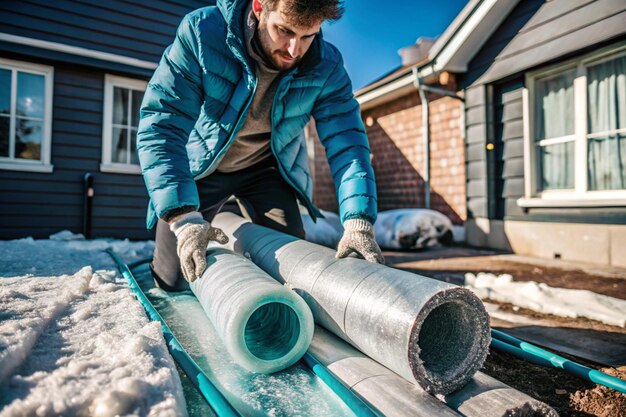
If you’ve been feeling drafts or noticing your energy bills creeping up, it might be time to consider an upgrade to your insulation. Blow-in insulation can be an excellent solution to enhance your home’s energy efficiency and comfort.
What Is Blow-in Insulation?
Blow-in insulation, also known as loose-fill insulation, involves using a machine to blow insulation materials into walls, attics, and other spaces in your home. It’s often made from materials like cellulose, fiberglass, or mineral wool, which are designed to trap air and reduce heat transfer.
Blow-in Insulation in Palatka, FL
360 Energy Spray Foam LLC, offers expert blow-in insulation services in Palatka, FL to enhance your home’s energy efficiency. Our team utilizes high-quality materials to effectively fill gaps, reducing energy costs and improving comfort. Enjoy a quieter, more efficient home with our tailored blow-in insulation solutions. Trust us to keep your home cozy and energy-efficient!
Advantages of Blow-in Insulation
The benefits of blow-in insulation are substantial:
- Improved Energy Efficiency: Blow-in insulation fills gaps and voids, providing a more effective barrier against heat loss and gain, helping to maintain a consistent temperature in your home.
- Lower Energy Bills: By improving insulation, you can reduce the amount of energy needed for heating and cooling, resulting in lower utility bills over time.
- Enhanced Comfort: Better insulation means fewer drafts and a more comfortable living environment year-round.
- Noise Reduction: Blow-in insulation can also help reduce sound transmission between rooms, making your home quieter.
- Environmentally Friendly Options: Many blow-in insulation materials, like cellulose, are made from recycled materials and are more sustainable.
Types of Blow-in Insulation
There are several materials used for blow-in insulation, including:
- Cellulose: Made from recycled paper products, cellulose is treated with fire retardants and is an eco-friendly option.
- Fiberglass: Lightweight and non-combustible, fiberglass is a common choice for blow-in insulation.
- Mineral Wool: Known for its fire resistance and soundproofing qualities, mineral wool is another effective option.
When to Consider Blow-in Insulation
If your home is older, you might want to evaluate your insulation. Signs that you may need blow-in insulation include fluctuating temperatures, high energy bills, or visible gaps in your current insulation.
Preparing for Blow-in Insulation Installation
Before installing blow-in insulation, here are some preparation tips:
- Assess Your Current Insulation: Check your existing insulation for any damage or areas that may need repair.
- Seal Air Leaks: Address any significant air leaks around windows, doors, and other openings to maximize efficiency.
- Choose a Qualified Contractor: Look for professionals experienced in blow-in insulation installation to ensure proper application.
Blow-in Insulation Installation Techniques
Here’s how the installation process generally works:
- Initial Inspection: A contractor will assess your home’s insulation needs and recommend the right material.
- Preparation: They will prepare the area, covering vents and ensuring a clean workspace.
- Blowing Insulation: Using a specialized machine, insulation is blown into the desired areas until they are adequately filled.
- Final Inspection: After installation, the contractor will inspect the area to ensure it meets safety and efficiency standards.
Tips for Effective Blow-in Insulation
For the best results, keep these tips in mind:
- Check Local Codes: Ensure that your installation meets local building codes and regulations.
- Consider R-Value: The R-value indicates insulation’s effectiveness. Higher R-values offer better insulation performance.
- Maintenance: Regularly check insulation in attics and walls, especially after significant weather events.
Benefits of Hiring Professionals vs. DIY
While some homeowners may consider a DIY approach, hiring professionals for blow-in insulation can save time and ensure a high-quality installation. Professionals have the necessary equipment and expertise to handle the job efficiently and safely.
Conclusion
Blow-in insulation is an effective way to enhance your home’s energy efficiency and comfort. With the right materials and proper installation, you can enjoy lower energy bills, improved comfort, and a quieter living space. Consider this upgrade for your home in Palatka, FL, and enjoy the benefits of a well-insulated home!
FAQs
What is blow-in insulation?
Blow-in insulation, or loose-fill insulation, is a type of insulation material that is blown into spaces such as attics, walls, and crawl spaces using a specialized machine. It effectively fills gaps and voids, enhancing energy efficiency.
What materials are commonly used for blow-in insulation?
Common materials include cellulose (made from recycled paper), fiberglass, and mineral wool. Each material has its benefits regarding thermal performance, fire resistance, and environmental impact.
How does blow-in insulation improve energy efficiency?
Blow-in insulation reduces air leaks and heat transfer, keeping your home warmer in winter and cooler in summer. This leads to reduced energy consumption and lower heating and cooling bills.
How do I know if I need blow-in insulation?
Signs include noticeable drafts, fluctuating indoor temperatures, high energy bills, or if your home is older and may not have adequate insulation.
Is blow-in insulation safe?
Yes, blow-in insulation is safe when installed correctly. Materials like cellulose are treated with fire retardants, and professionals ensure proper handling to minimize any health risks.
How long does the installation process take?
The installation of blow-in insulation typically takes a few hours, depending on the size of the area being insulated. A professional can give a more accurate estimate based on your specific needs.
Can I install blow-in insulation myself?
While some homeowners may choose to DIY, it’s generally recommended to hire a professional for blow-in insulation. Proper installation is crucial for effectiveness and safety.
How much does blow-in insulation cost?
Costs can vary based on the size of the area, the type of insulation material used, and local labor rates. It’s best to get a quote from a professional contractor for a more accurate estimate.
How long will blow-in insulation last?
Blow-in insulation can last for many years, often over 20 years, if properly installed and maintained. However, periodic inspections are recommended to check for settling or moisture issues.
Does blow-in insulation help with soundproofing?
Yes, blow-in insulation can help reduce sound transmission between rooms, making your home quieter.